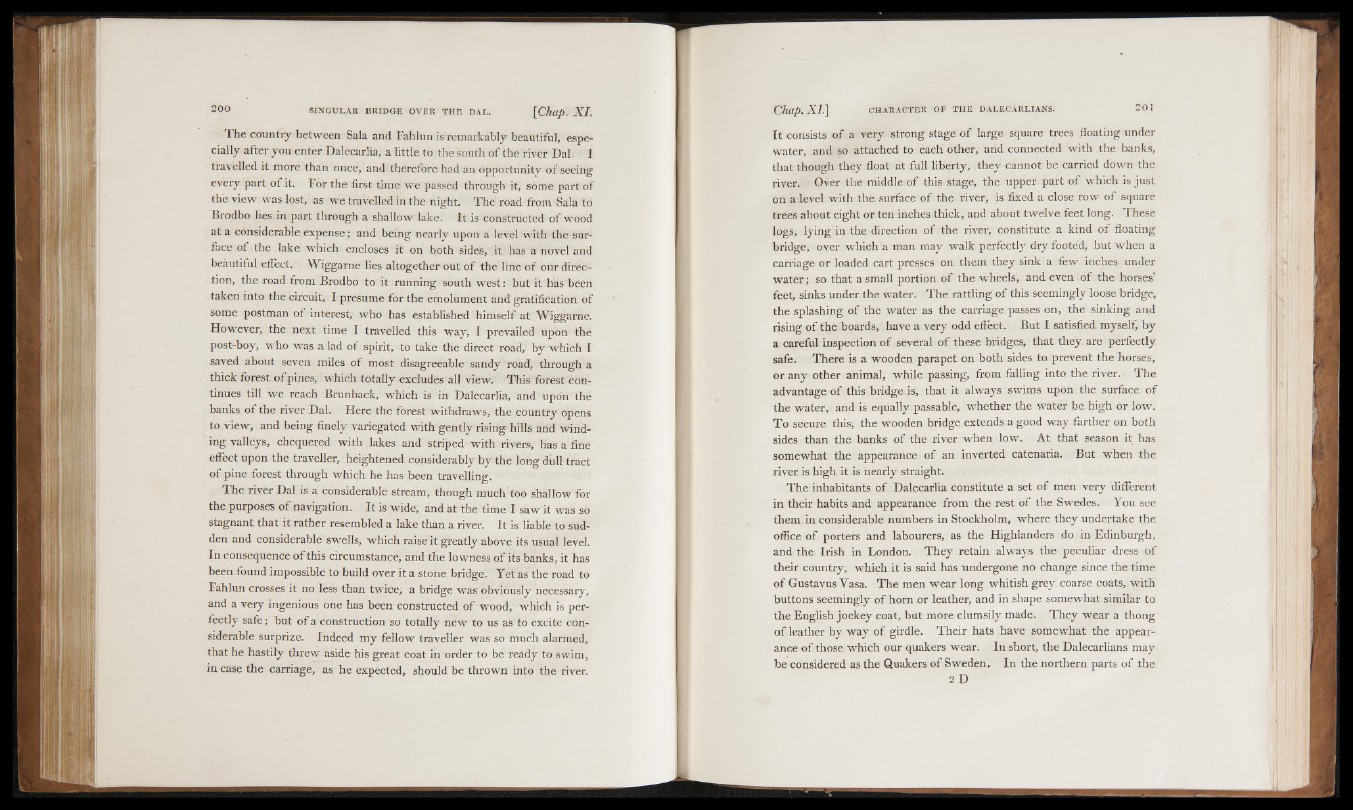
The country between Sala and Fahlun is remarkably beautiful, especially
after you enter Dalecarlia, a little to the south o f the river Dal. I
travelled it more than once, and therefore had an opportunity of seeing
every part of it. For the first time we passed through it, some part of
the view was lost, as we travelled in the night. The road from Sala to
Brodbo lies in part through a shallow lake. It is; constructed of wood
at a considerable expense; and being nearly upon a level with the surface
o f the lake which encloses it on both sides, it has a novel and
beautiful effect. Wiggarne lies altogether out of the line of our direction,
the road from Brodbo to it running south west: but it has been
taken into the circuit, I presume for the emolument and gratification of
some postman o f interest, who has established himself at Wiggarne.
However, the next time I travelled this way, I prevailed upon the
post-boy, who was a lad o f spirit, to take the direct road, by which I
saved about seven miles o f most disagreeable sandy road, through a
thick forest o f pines, which totally excludes all view. This forest continues
till we reach Brunback, which is in Dalecarlia, and upon the
banks o f the river Dal. Here the forest withdraws, the country opens
to view, and being finely variegated with gently rising hills and winding
valleys, chequered with lakes and striped with riyers, has a fine
effect upon the traveller, heightened considerably by the long dull tract
o f pine forest through which he has been travelling.
The river Dal is a considerable stream, though much too shallow for
the purposes o f navigation. It is wide, and at the time I saw it was so
stagnant that it rather resembled a lake than a river. It is liable to sudden
and considerable swells, which raise it greatly above its usual level.
In consequence of this circumstance, and the lowness of its banks, it has
been found impossible to build over it a stone bridge. Yet as the road to
Fahlun crosses it no less than twice, a bridge was obviously necessary,
and a very ingenious one has been constructed of wood, which is perfectly
safe; but o f a construction so totally new to us as to excite considerable
surprize. Indeed my fellow traveller was so much alarmed,
that he hastily threw aside his great coat in order to be ready to swim,
in case the carriage, as he expected, should be thrown into the river.
It consists o f a very strong stage o f large square trees floating under
water, and so attached to each other, arid connected with the banks,
that though they float at full liberty, they cannot be carried down the
river. Over the middle of this stage, the upper part o f which is just
on a level with the surface of the river, is fixed a close row o f square
trees about eight or ten inches thick, and about twelve feet long. These
logs, lying in the direction o f the river, constitute a kind of floating
bridge, over which a man may walk perfectly dry footed, but when a
carriage or loaded cart presses on them they sink: a few finches under
water; so that a small portion.of the wheels, and even of the horses’
feet, sinks under the. water. The rattling of this seemingly loose bridge,
the splashing of the water as the carriage passes on, the sinking and
rising of the boards, have a very odd effect. But I satisfied myself, by
a careful inspection of several o f these bridges, that they are perfectly
safe. There is a wooden parapet on both sides to prevent the horses,
or any other animal, while passing, from falling into the river. The
advantage o f this bridge is, that it always swims upon the surface of
the water, and is equally passable, whether the water be high or low.
To secure this, the wooden bridge extends a good way farther on both
sides than the banks of the river when low. At that season fit has
somewhat the appearance o f an inverted catenaria. But when the
river is high it is nearly straight.
The inhabitants o f Dalecarlia constitute a set o f men very different
in their habits and appearance from the rest of the Swedes. You see
them in considerable numbers in Stockholm, where they undertake the
office of porters and labourers, as the Highlanders do in Edinburgh,
and the Irish in London. They retain always the peculiar dress of
their country, which it is said has undergone no change since the time
of Gustavus Yasa. The men wear long whitish grey coarse coats,¡with
buttons seemingly of horn or leather, and in shape somewhat similar to
the English jockey coat, but more clumsily made. They wear a thong
of leather by way o f girdle. Their hats have somewhat the appearance
of those which our quakers wear. In short, the Dalecarlians may
be considered as the Quakers of Sweden. In the northern parts o f the
2 D